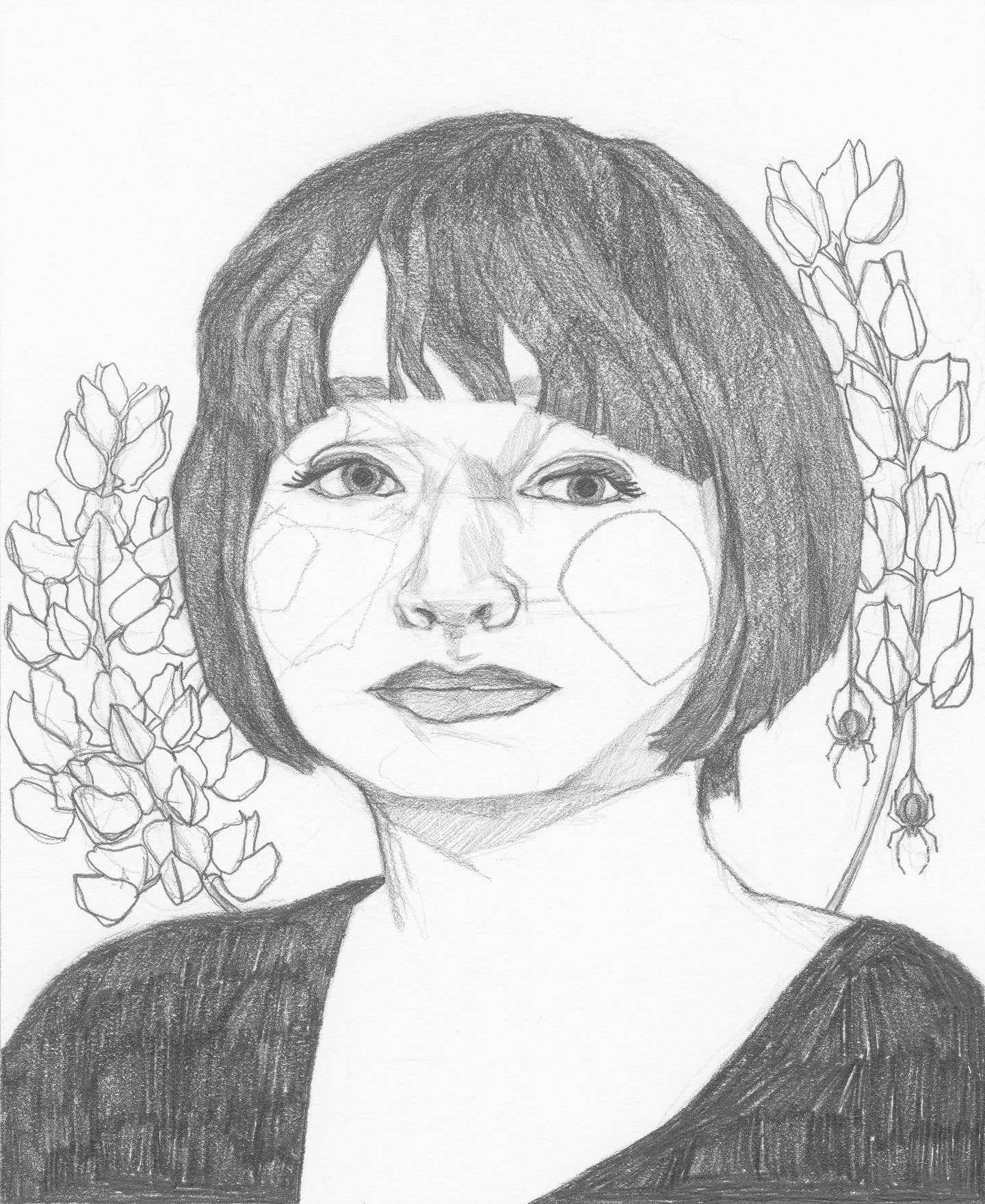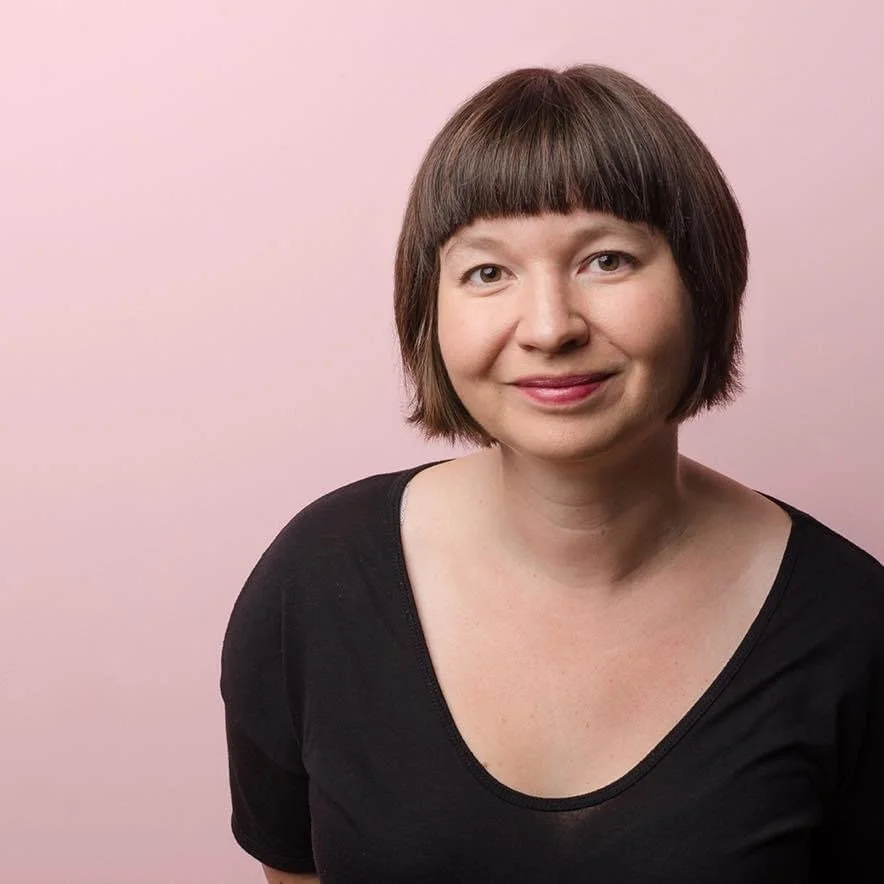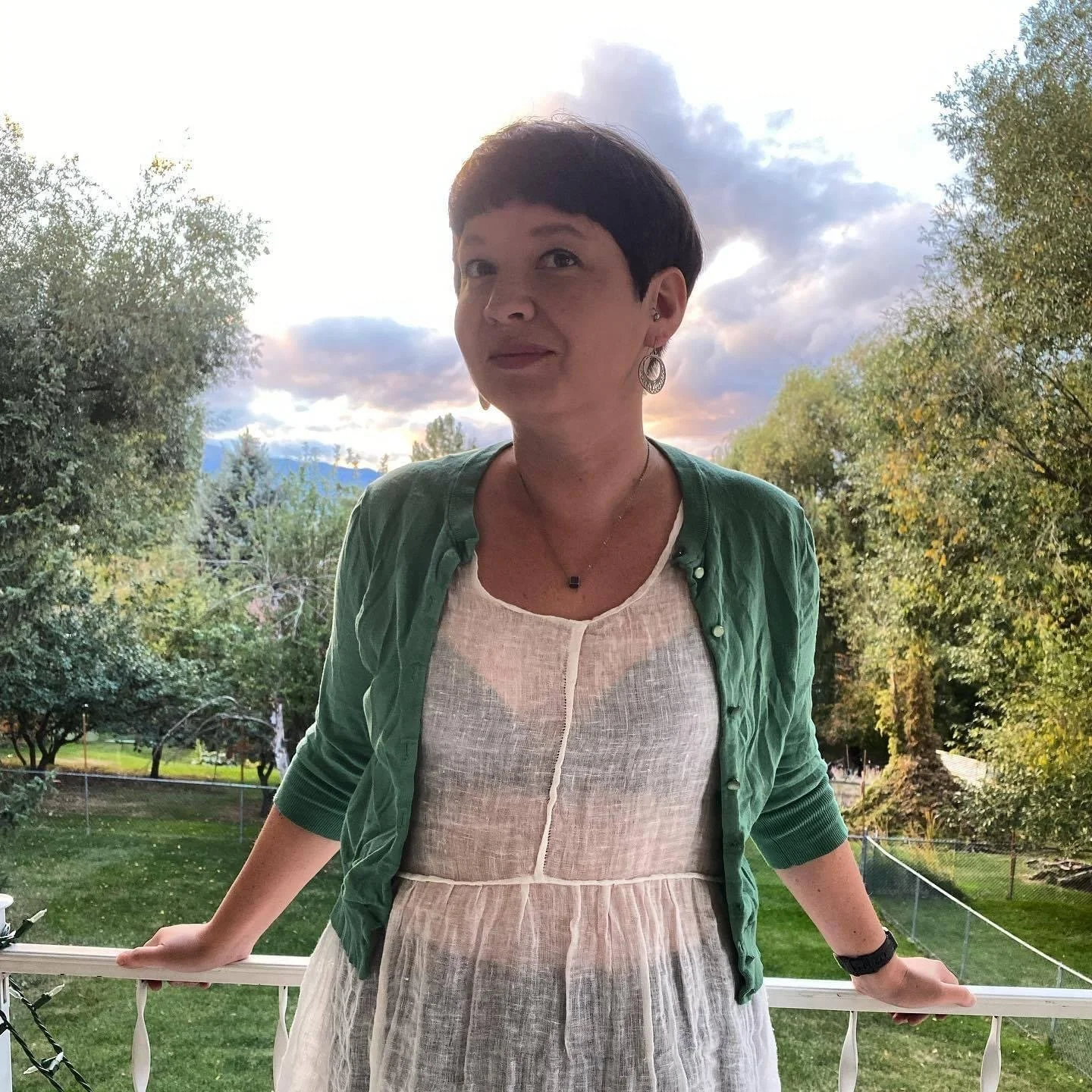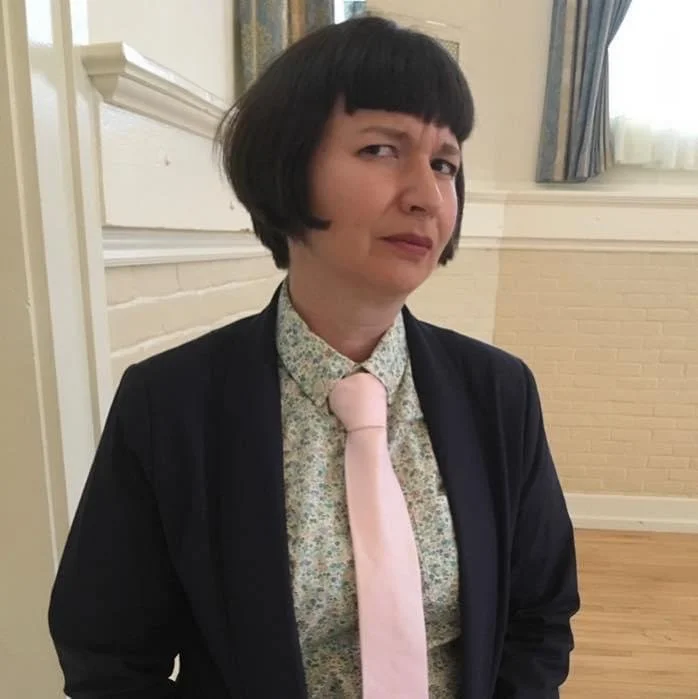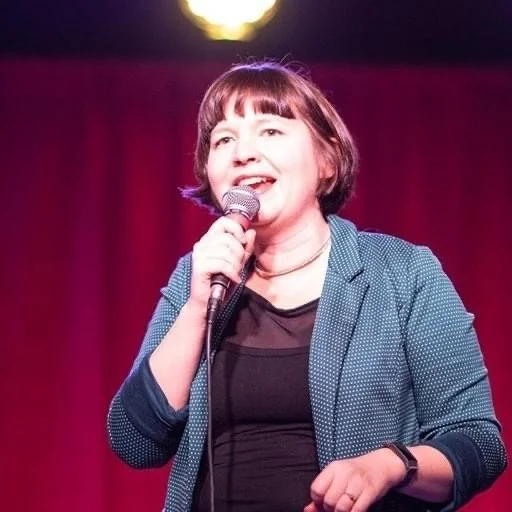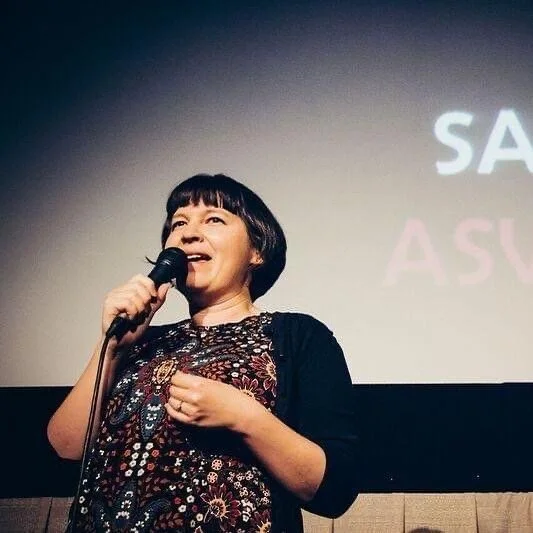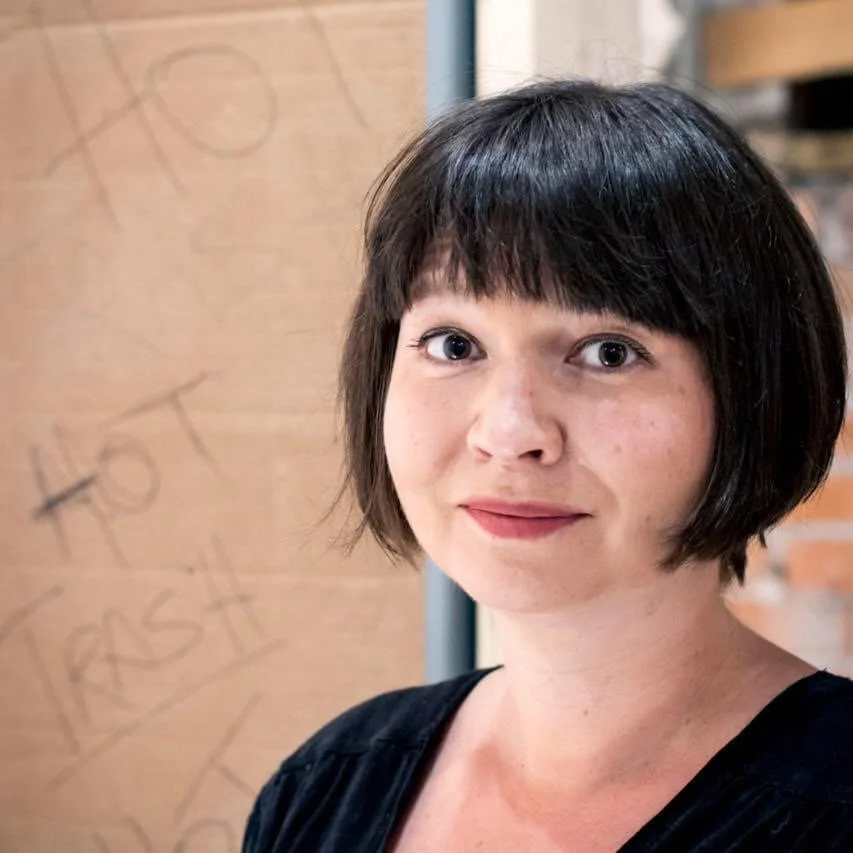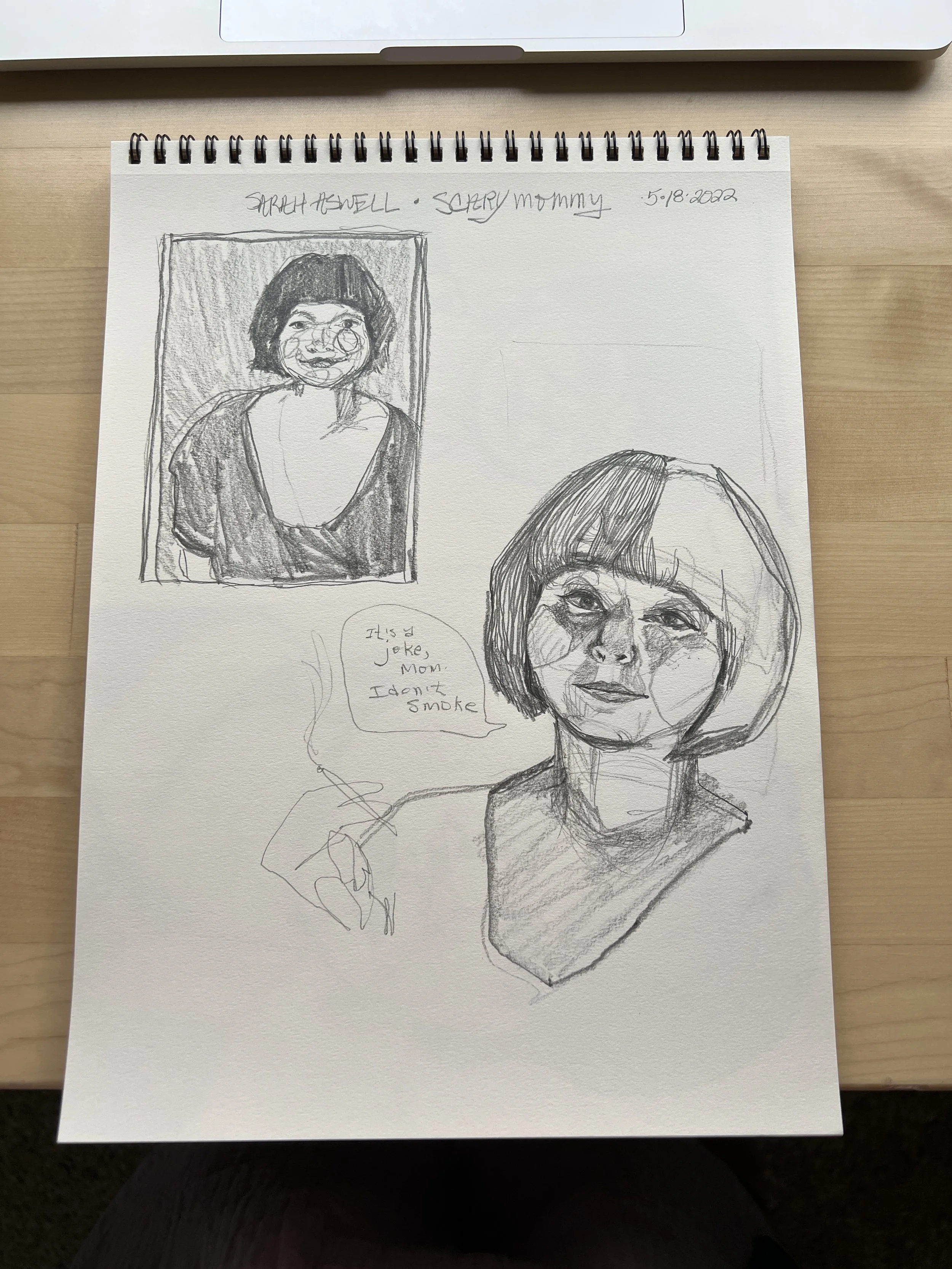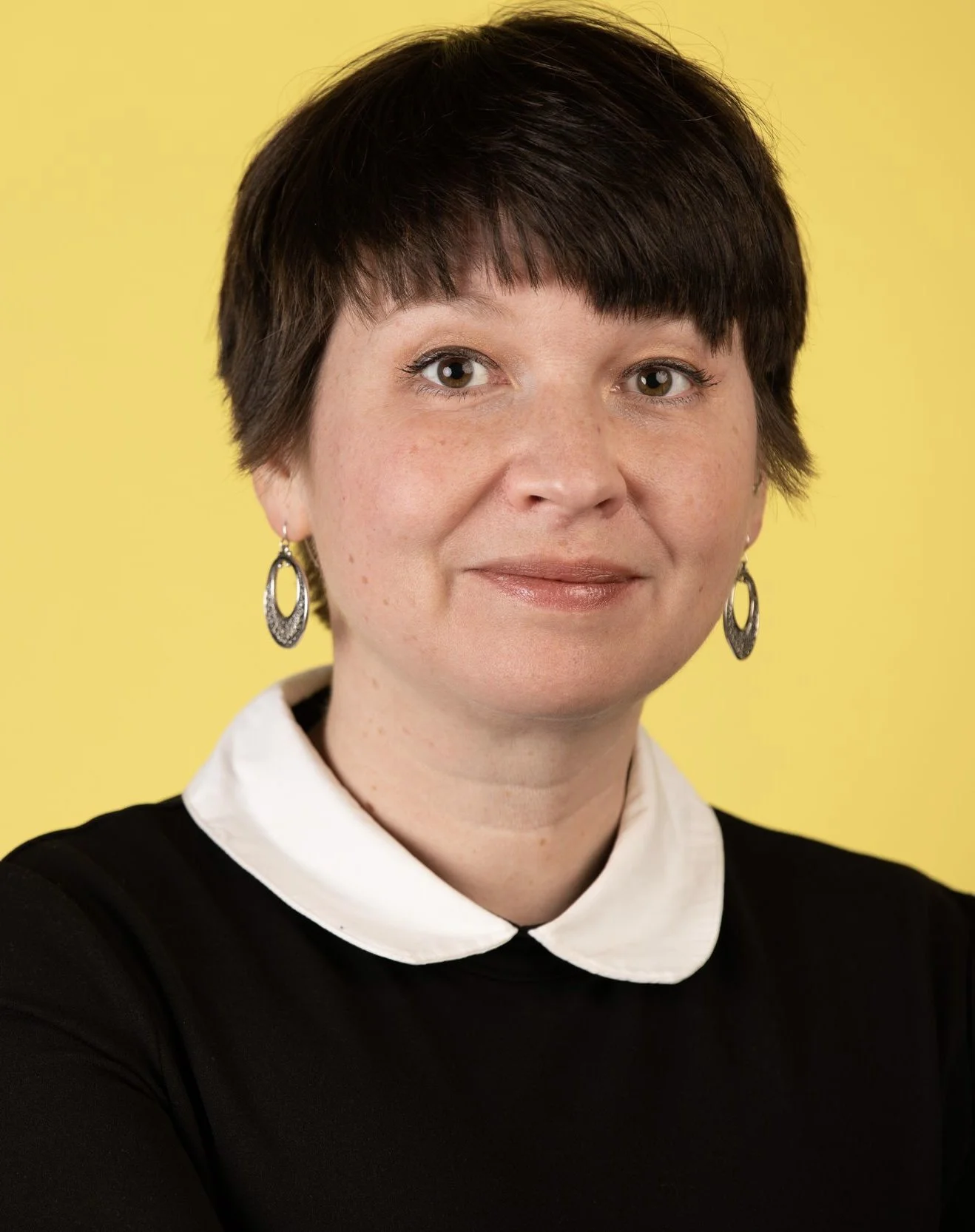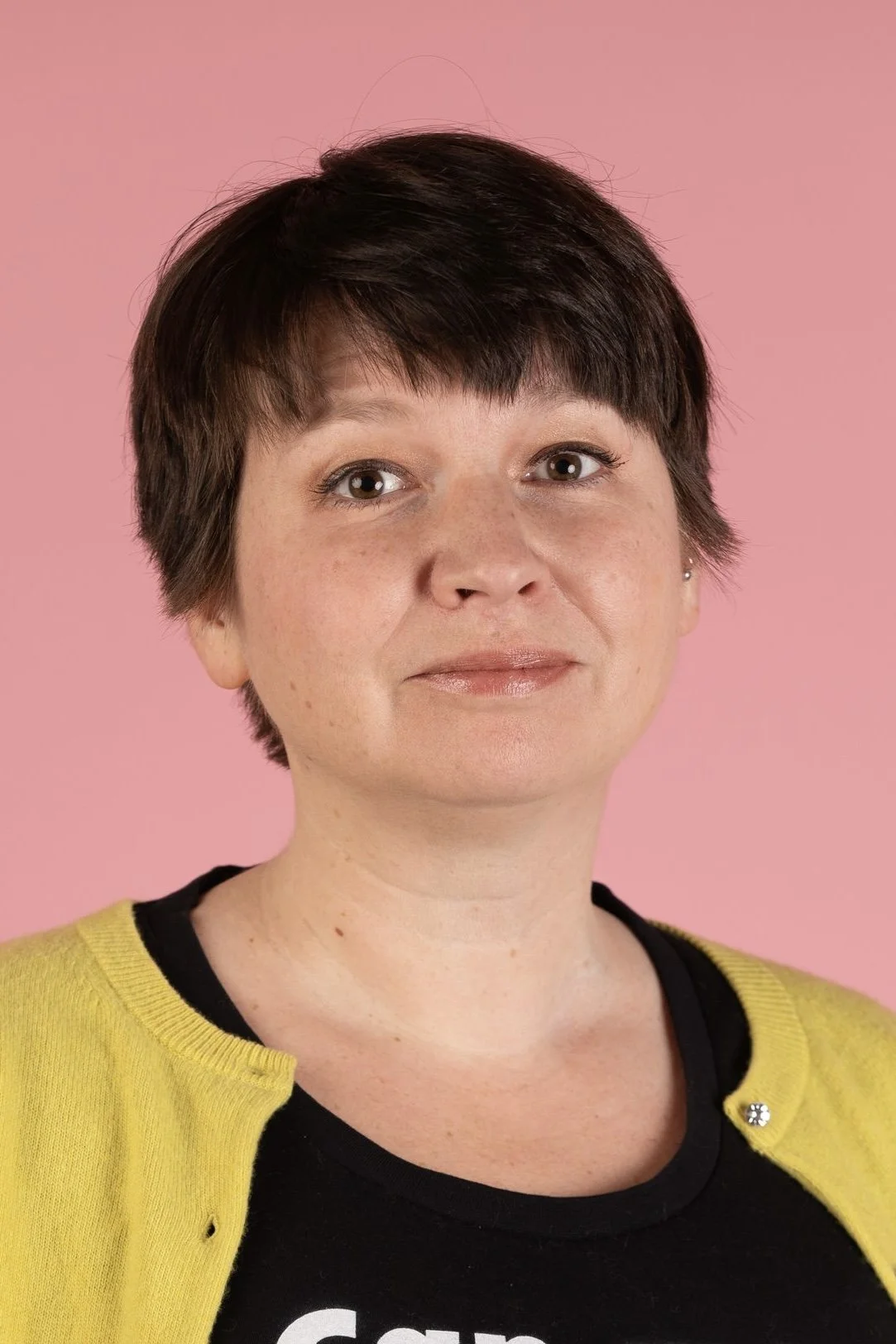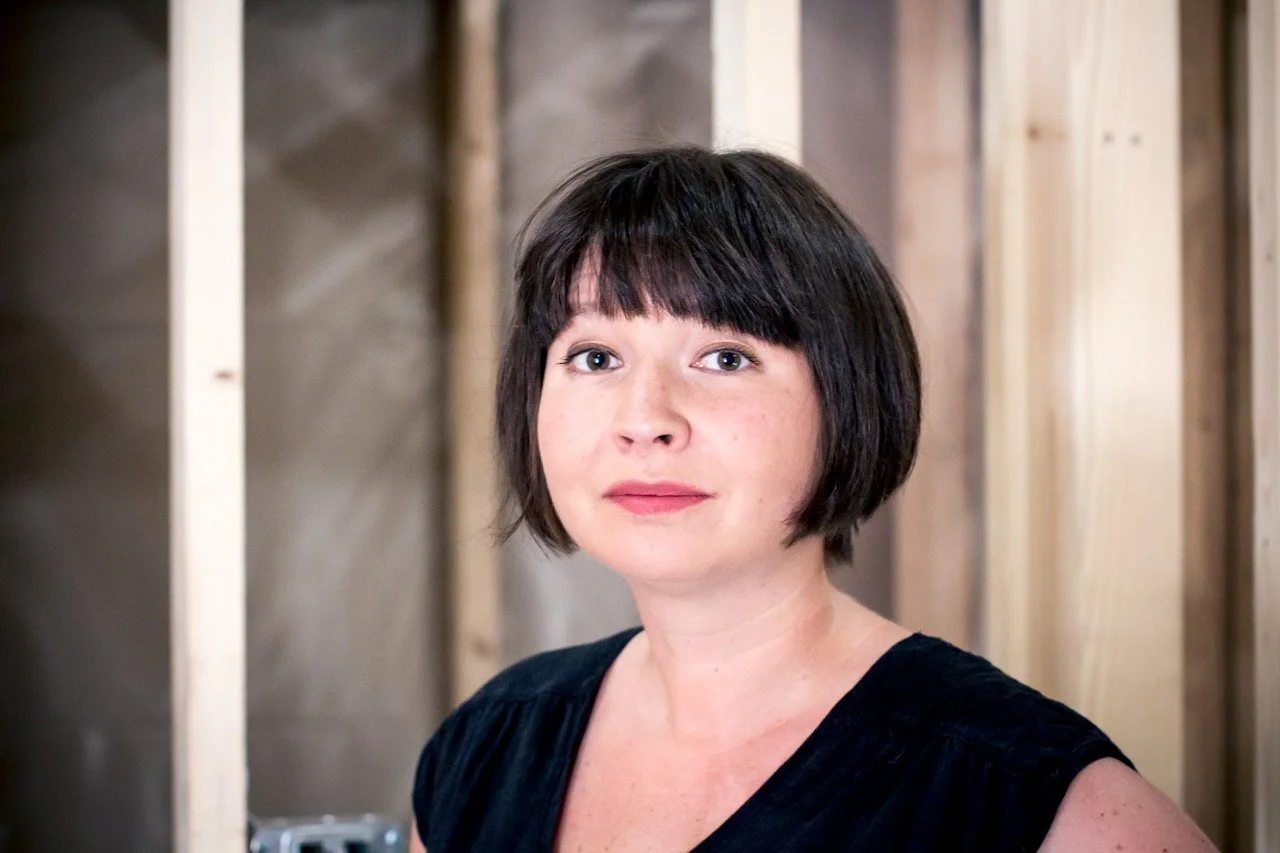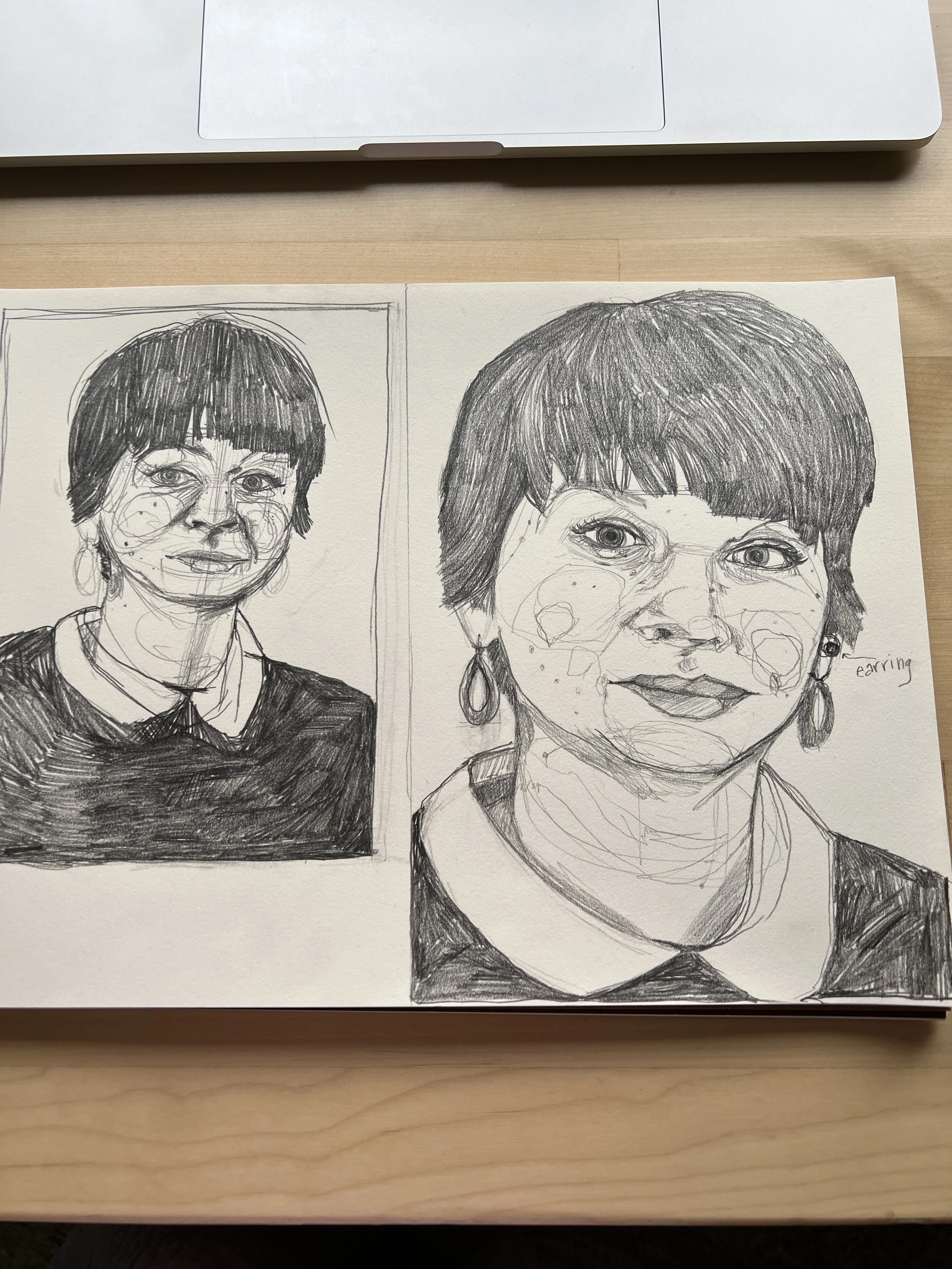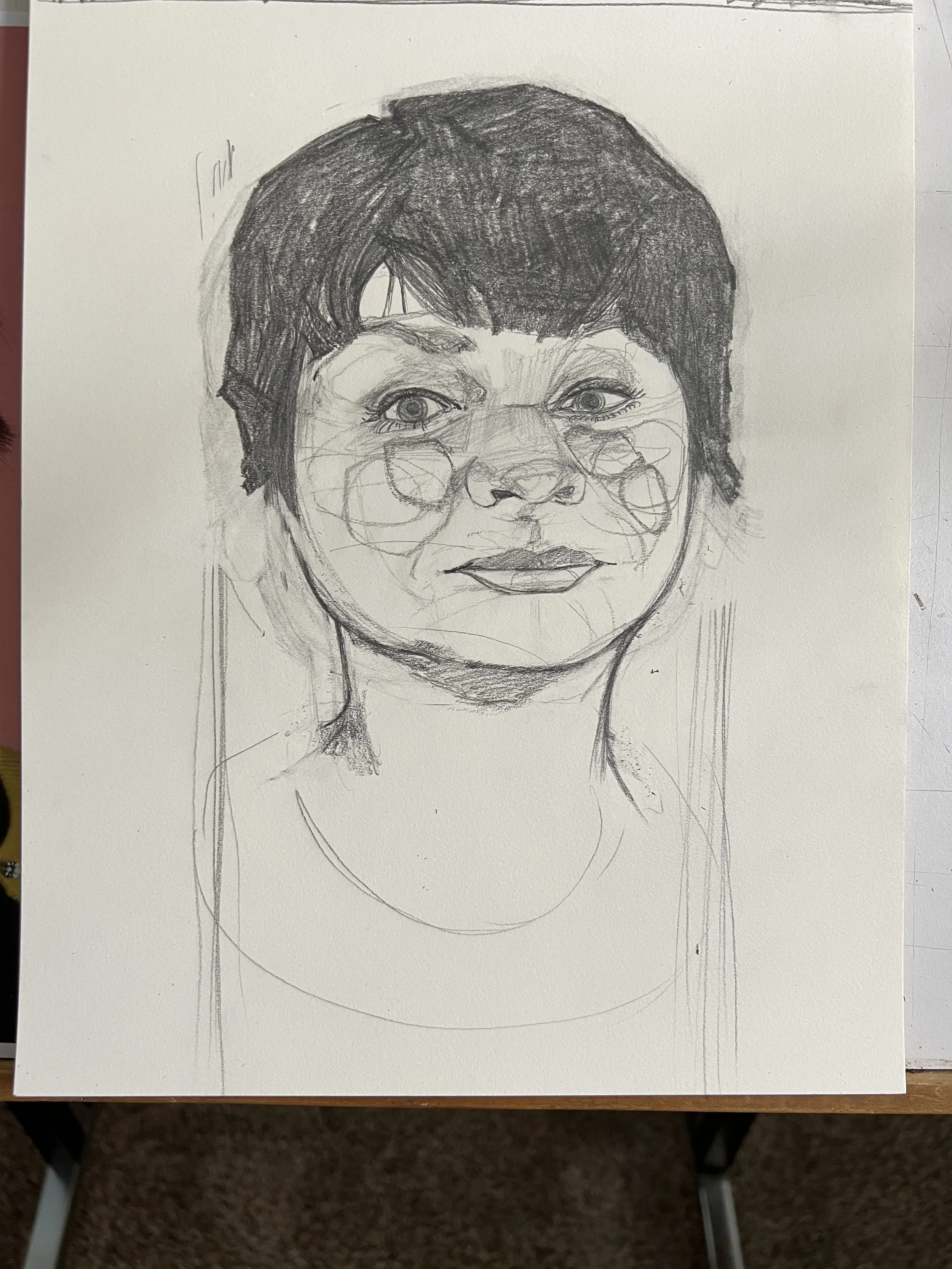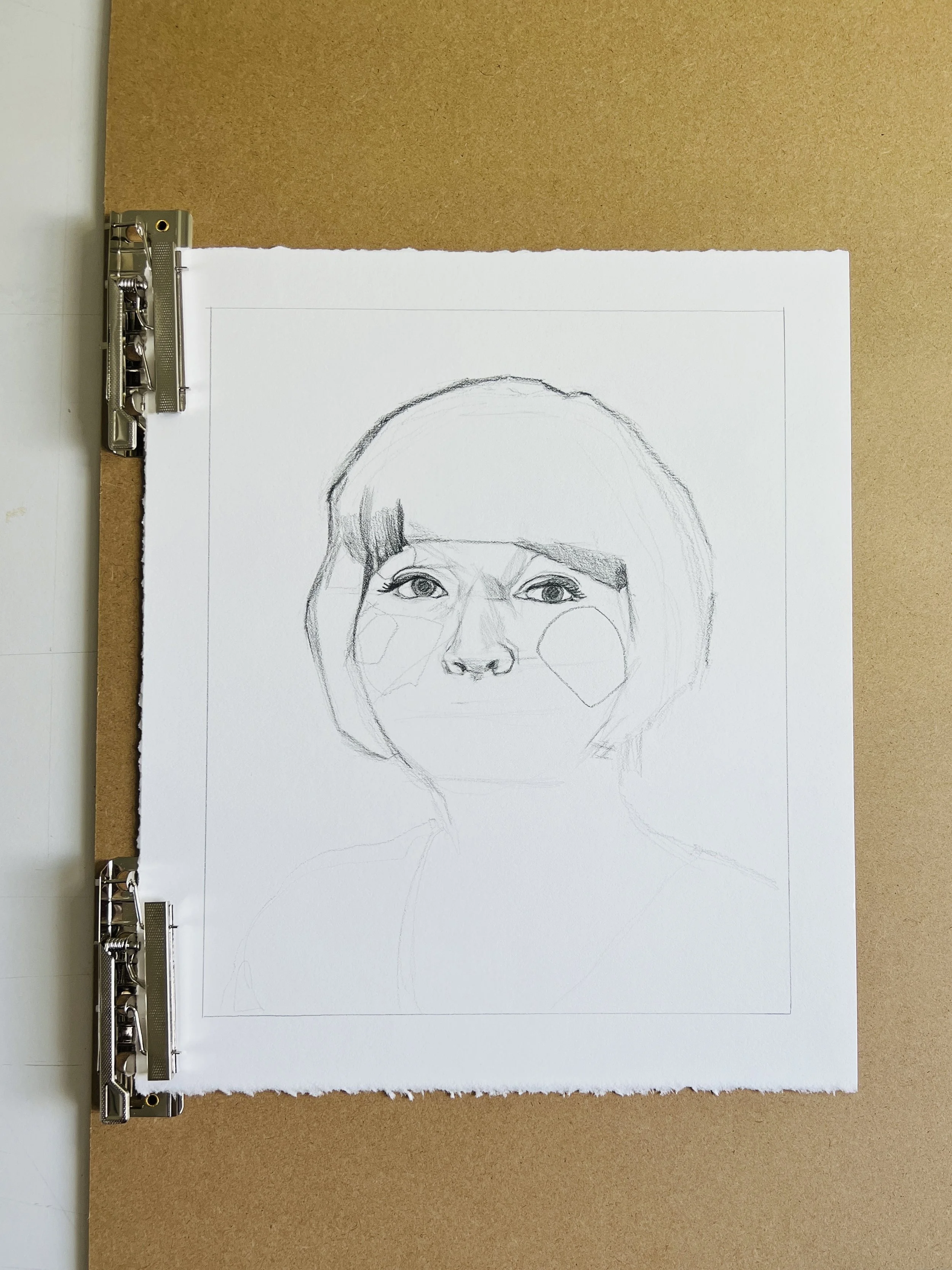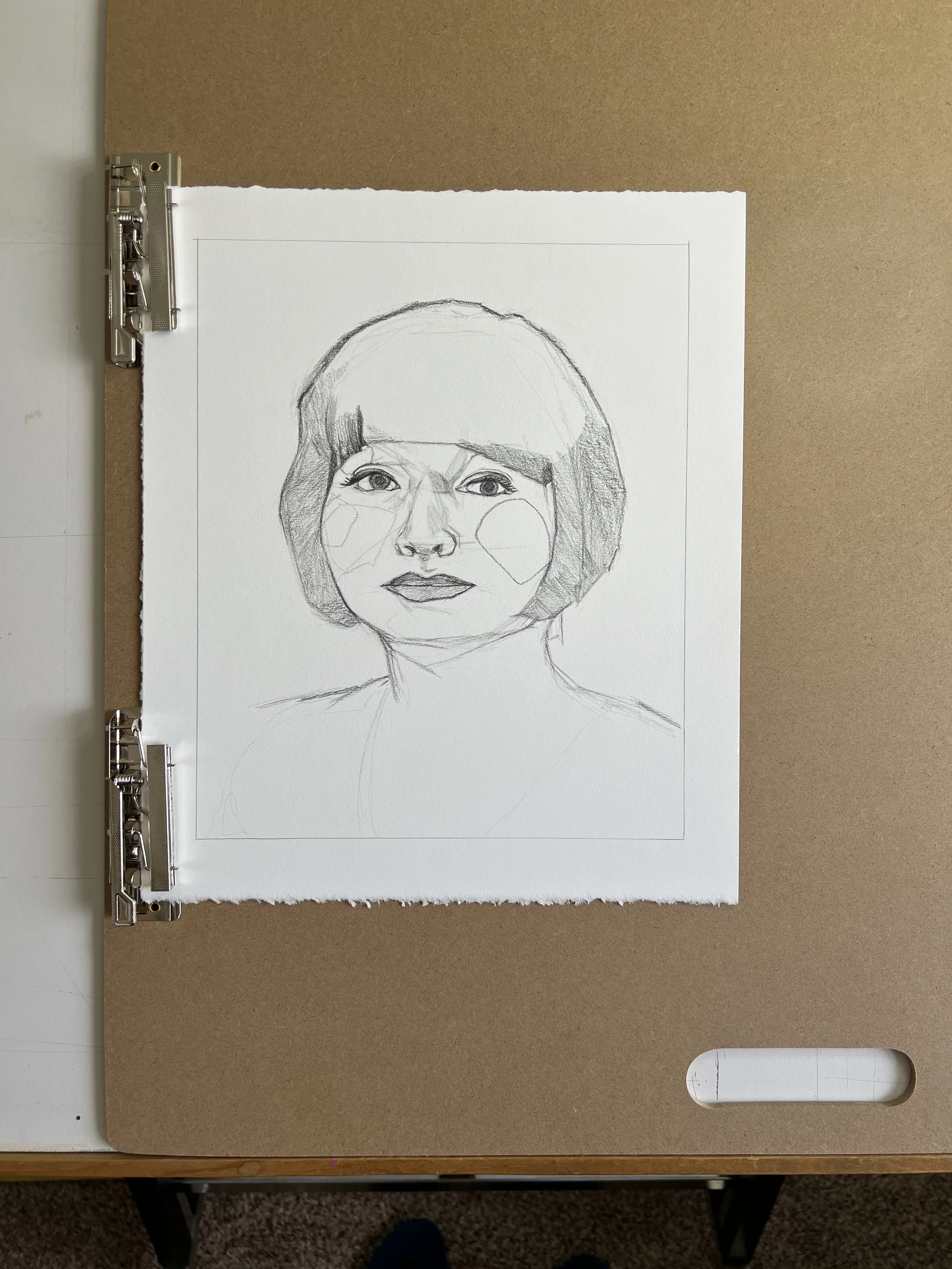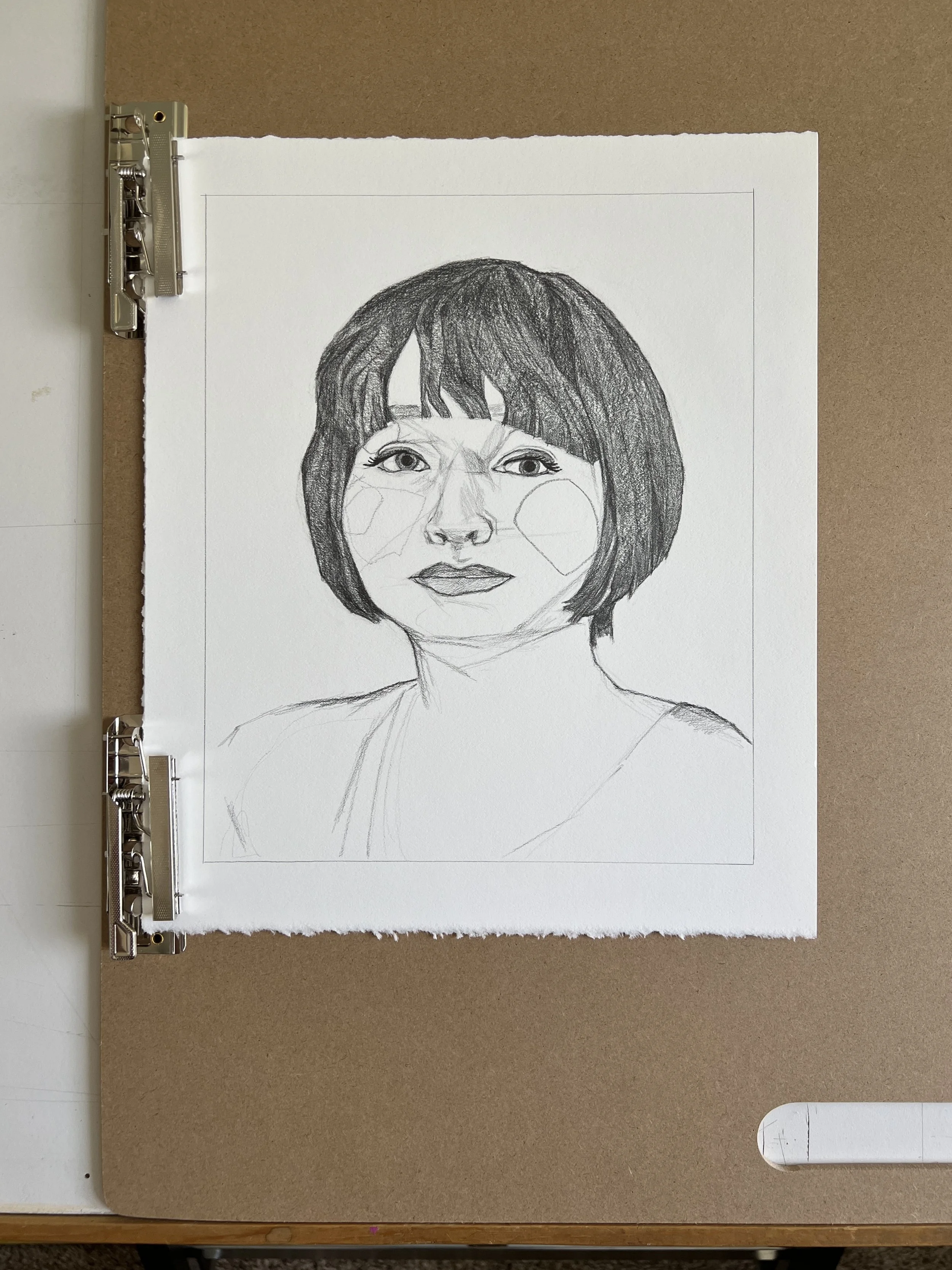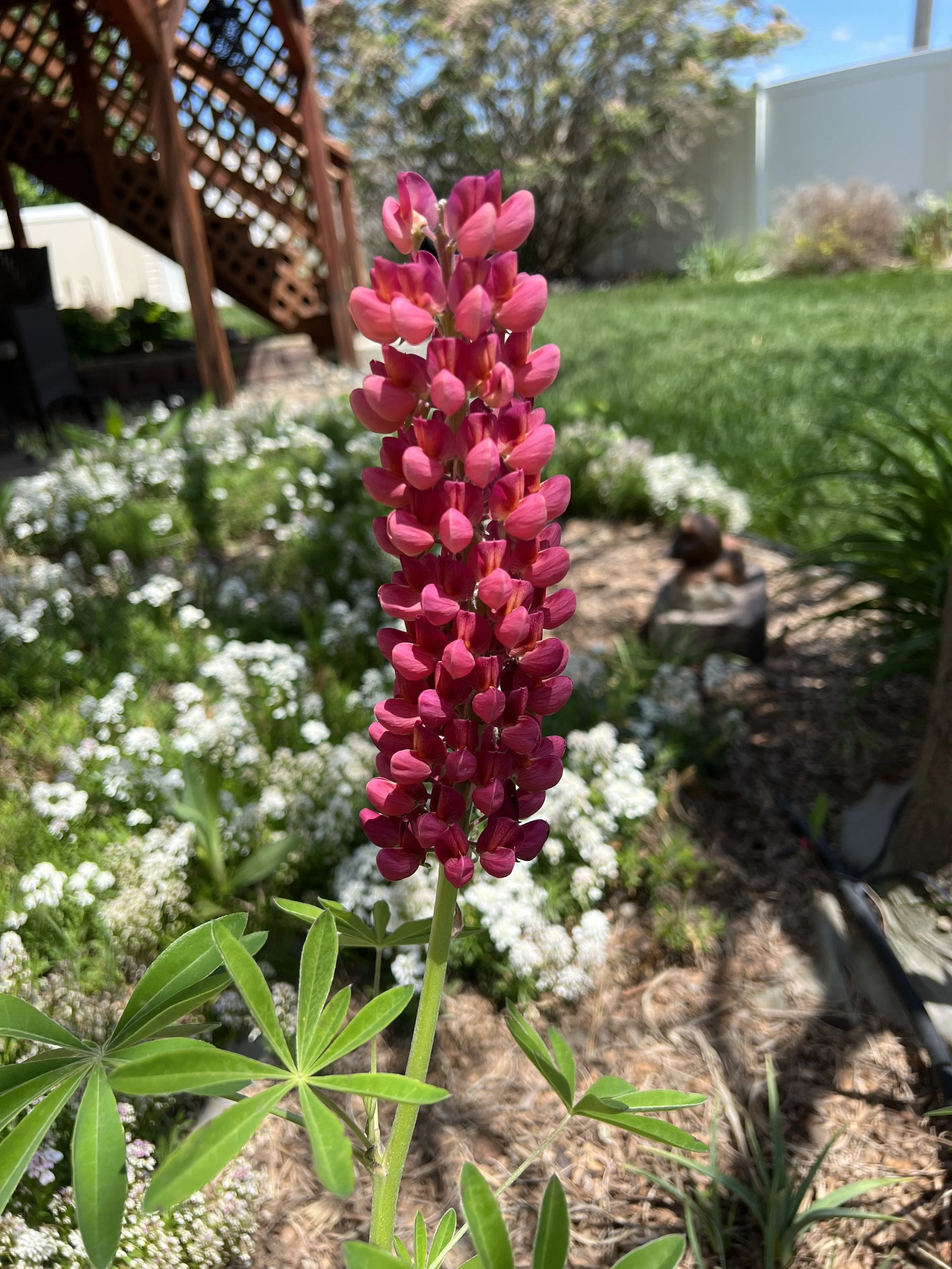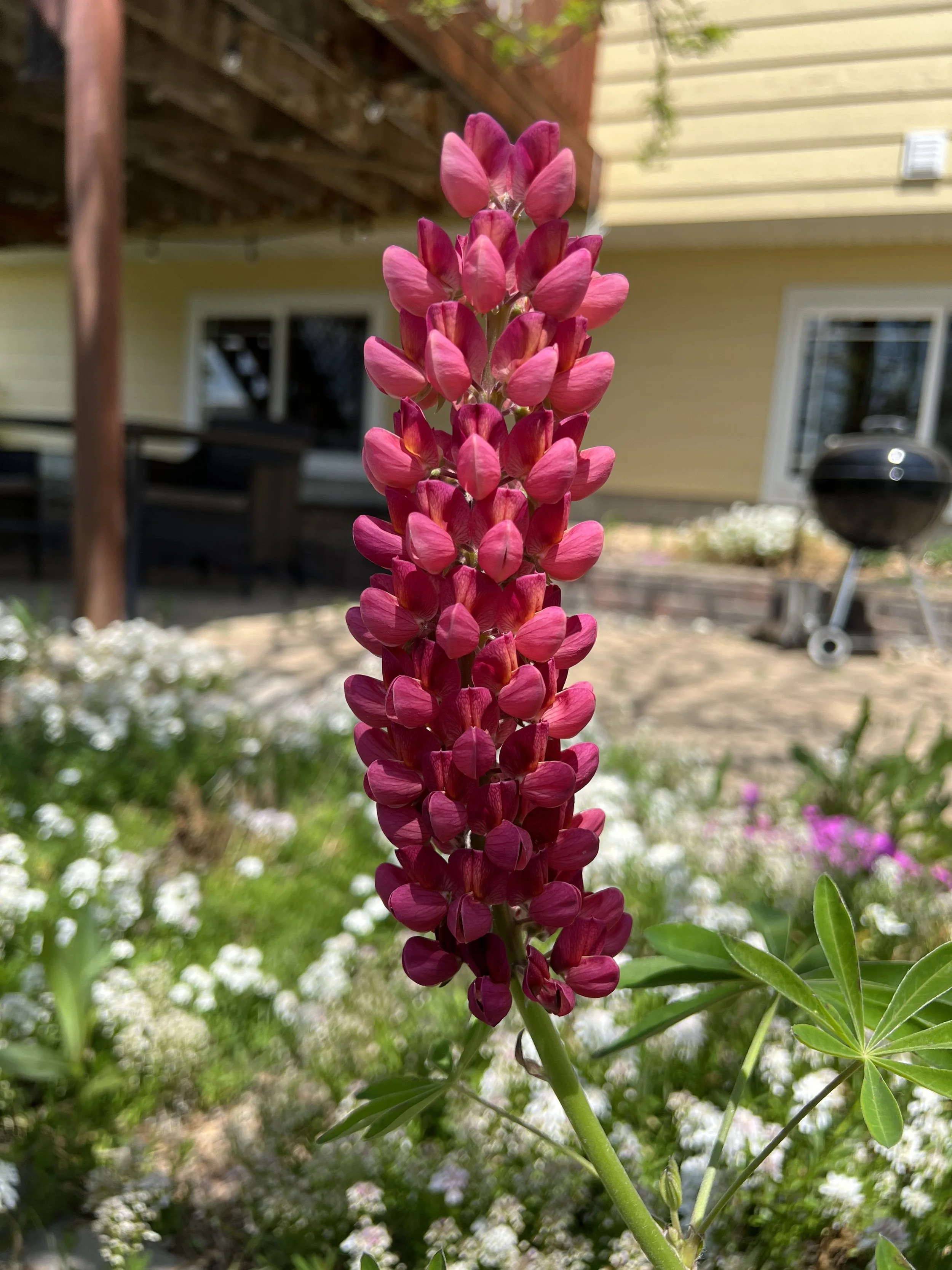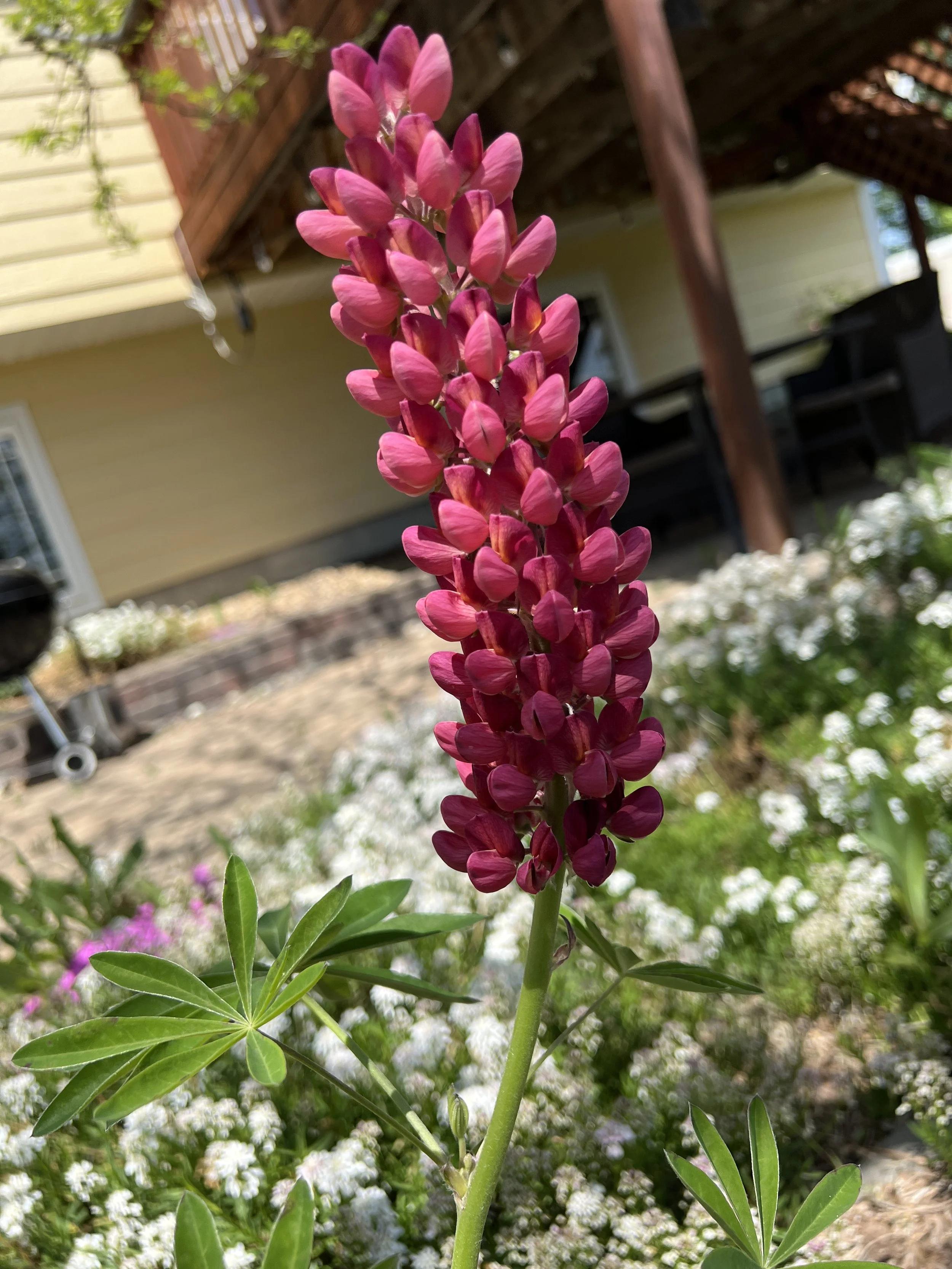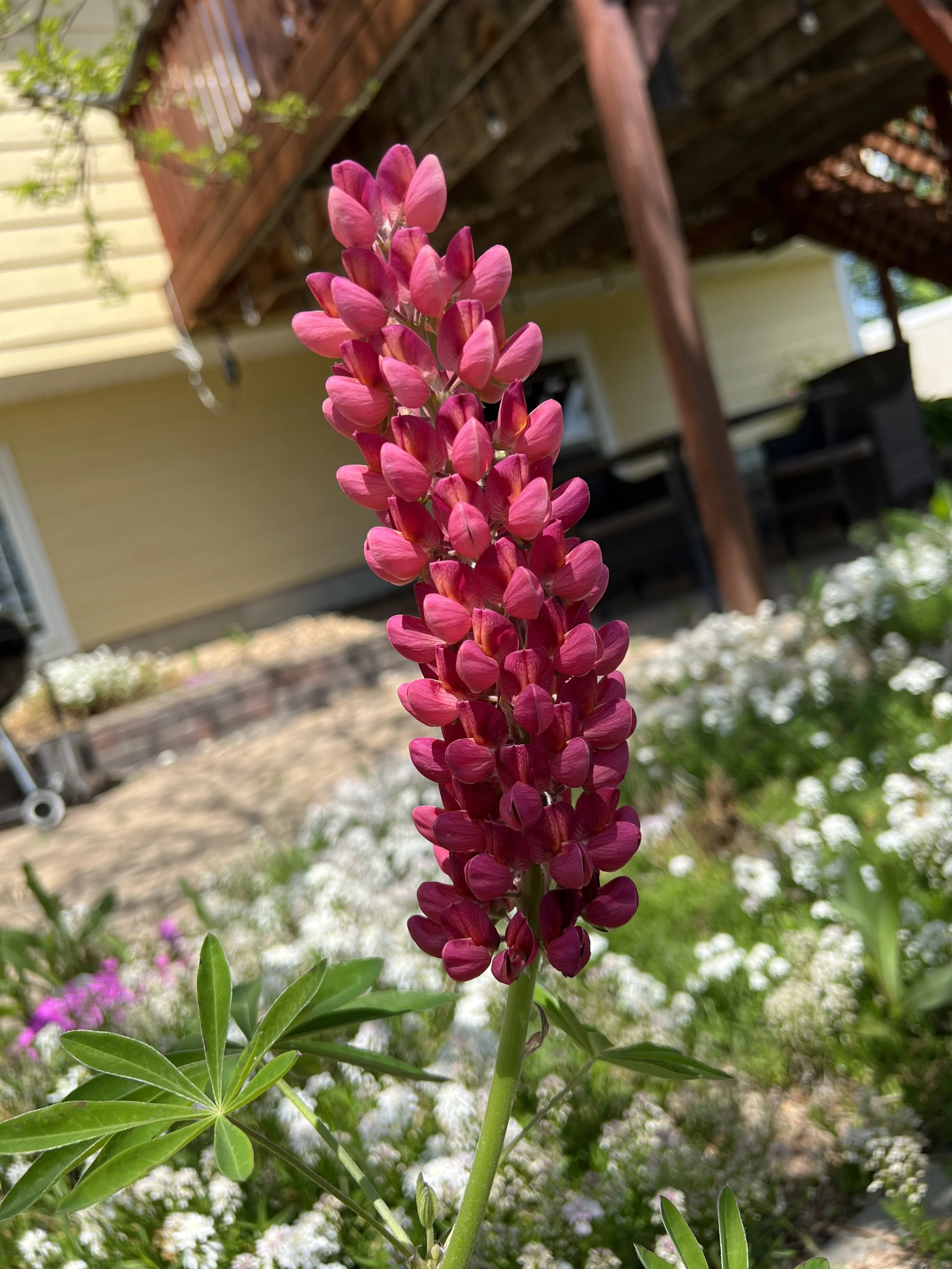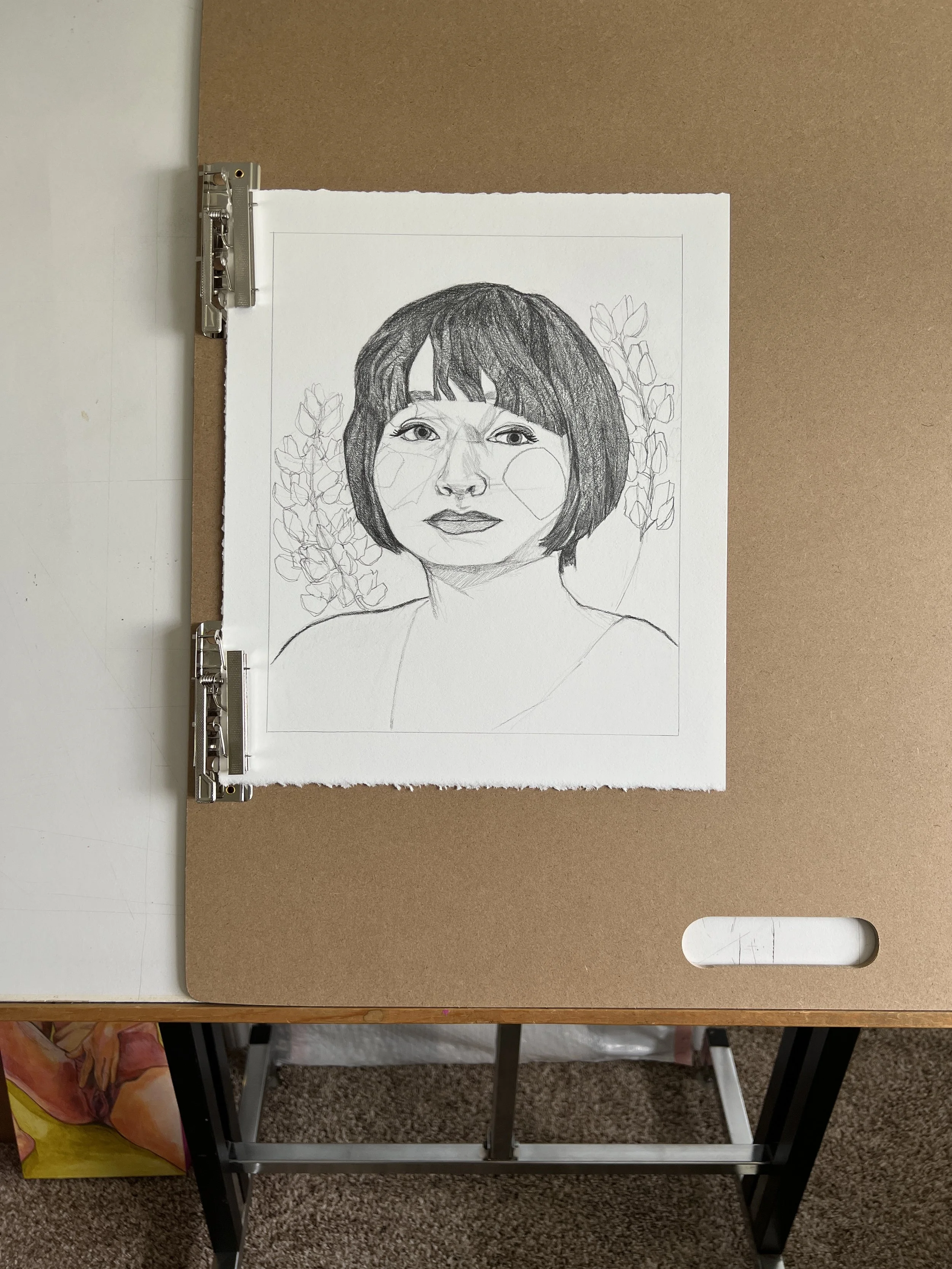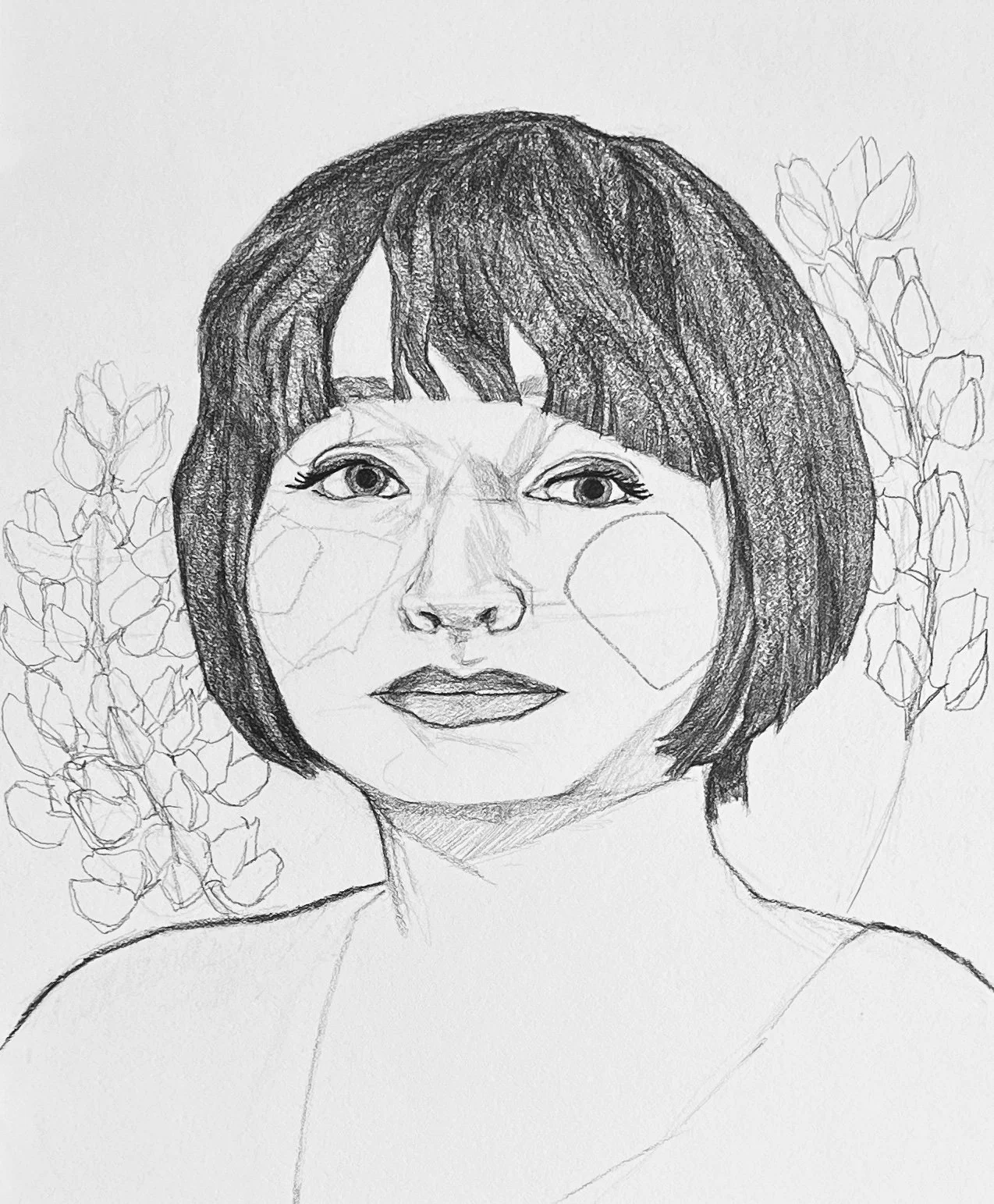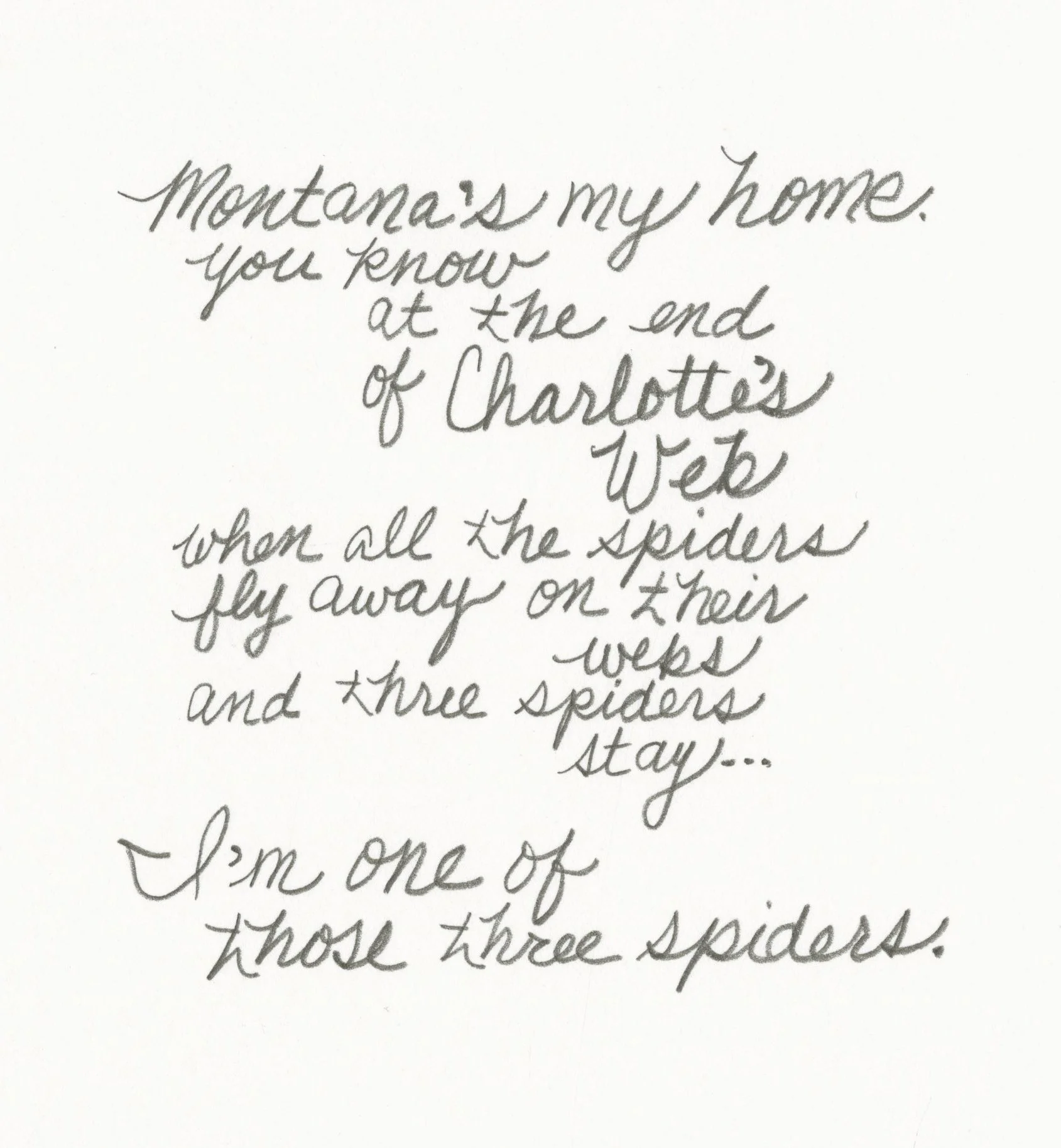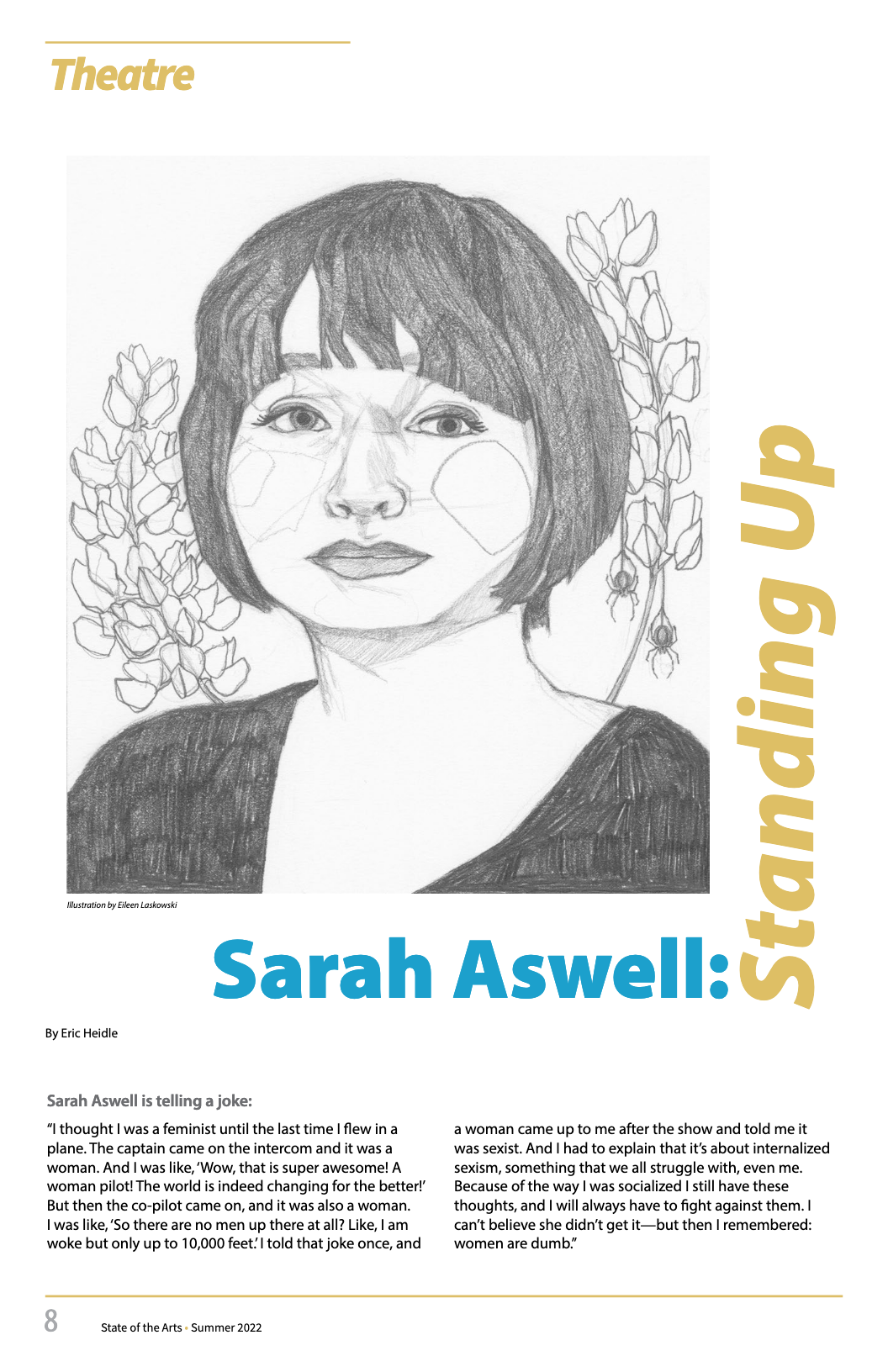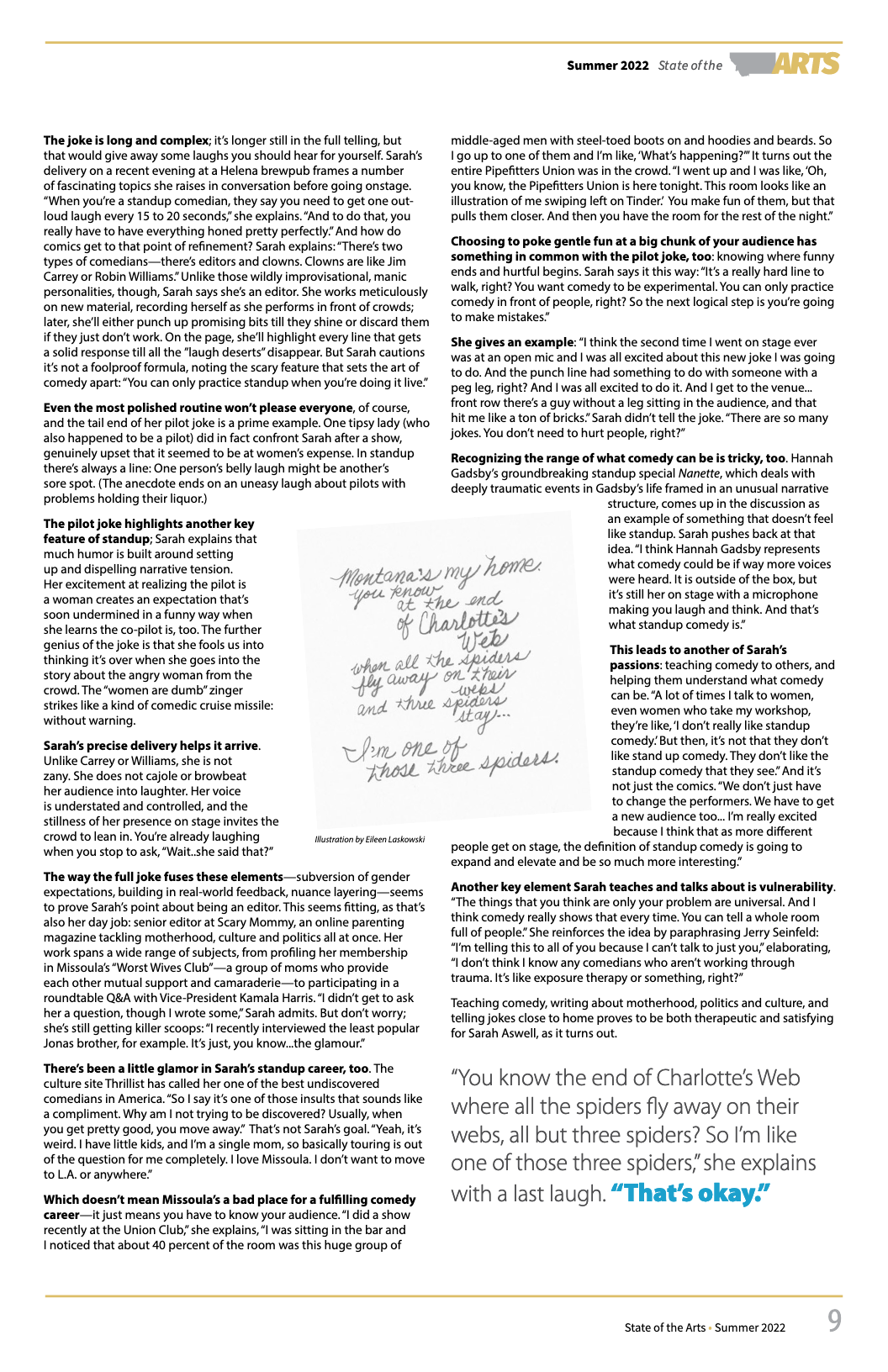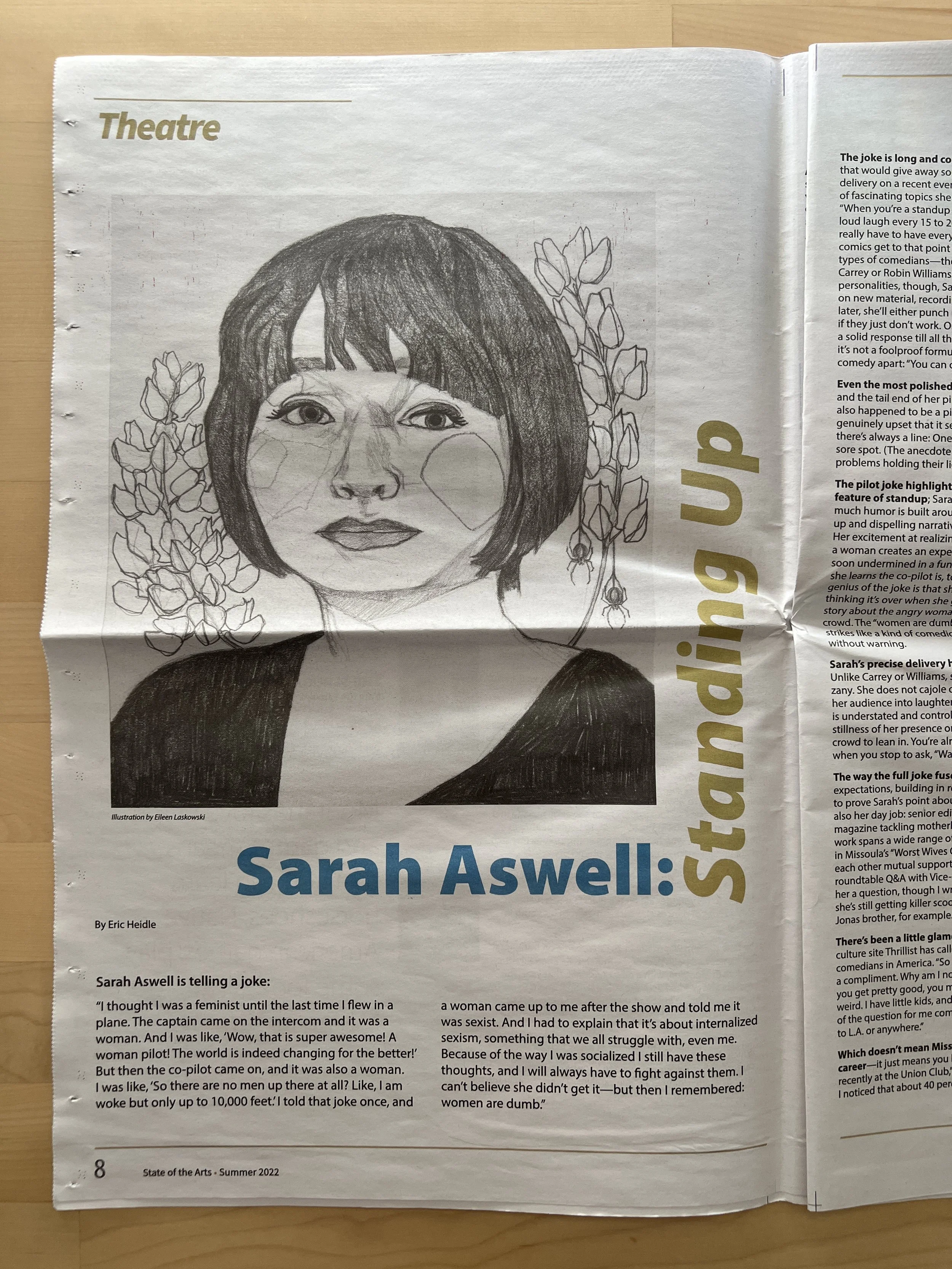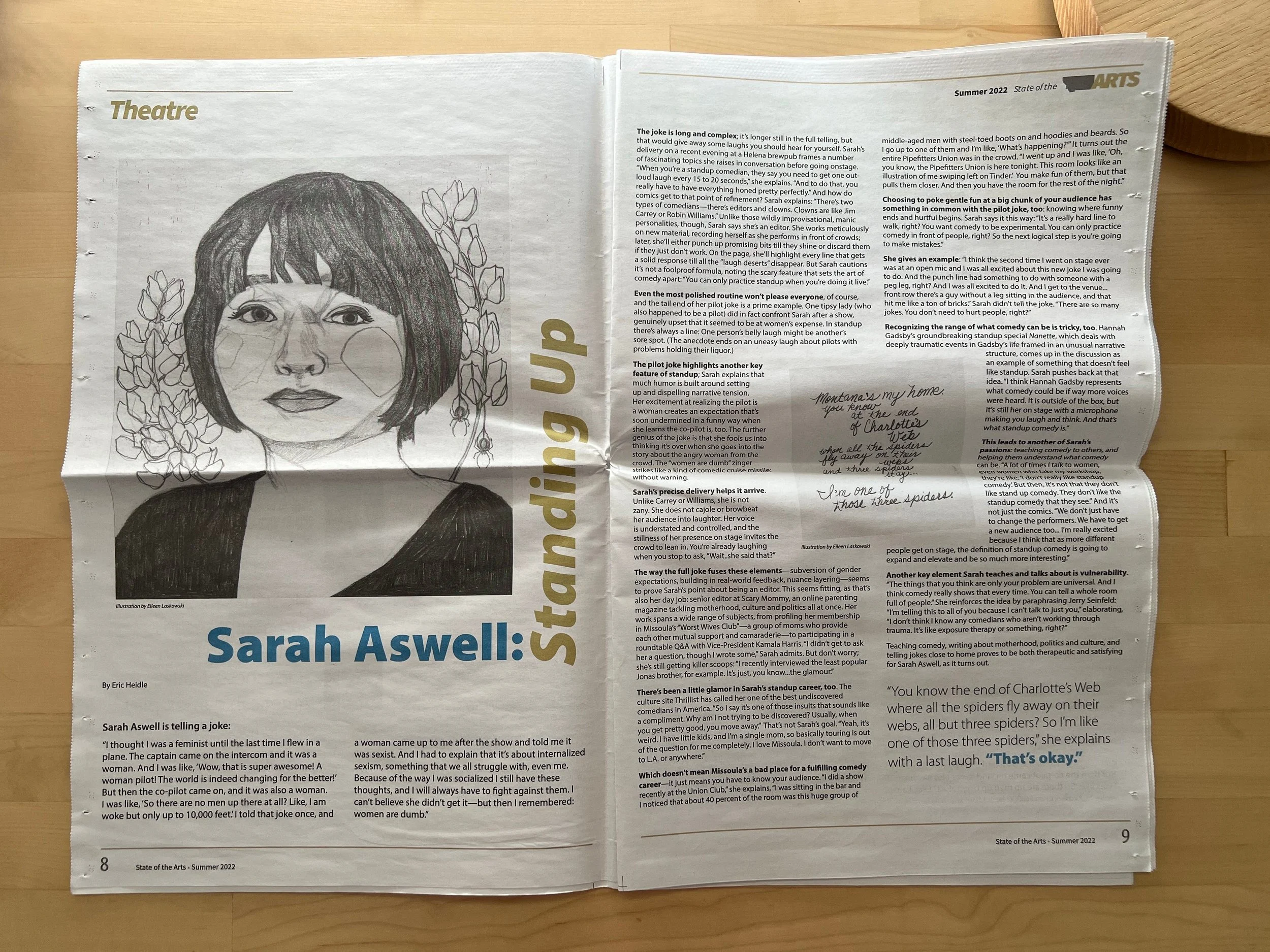Sarah Aswell: Standing Up
Recently I had the opportunity to illustrate the portrait of professional stand-up comedian, Sarah Aswell.
Drawing of Sarah Aswell with Montana lupine flowers and barn spiders, 2022.
Sarah Aswell is a well-known comedian in Montana. She is also a contributing writer for places such as The New Yorker, USA Today, Forbes, and Reductress, to name a few. When I was asked by the Montana Arts Council to draw her portrait for a feature interview within the summer issue of their quarterly publication, State of the Arts, I was a bit starstruck at first, and then immediately agreed.
The Illustration Process
The first step in the process of illustrating Sarah’s portrait was to discuss the desired look of the illustration with the art director for Montana Arts Council. It was difficult at first to nail something down because there were many routes we could take, as Sarah is not only a stand-up comedian, but also a single mother, accomplished writer, and professional editor. The art director and I discussed drawing something that had a sort of political cartoon look — a drawing that illustrated movement and something happening. We discussed Sarah’s “cool” factor; the many cardigans that have become her on-stage signature attire; her role as a single mother; and her professional position as a senior editor at Scary Mommy. We both agreed that something with movement could help illustrate the many hats that Sarah wore, and that these roles could be drawn as objects floating around her in the form of speech bubbles, cardigans, and microphones.
My next step was to gather reference imagery. At this point, Sarah knew I was the artist for her interview, and so I friended her on Facebook and began scrolling through her profile photos. I made my best effort to collect images of her that I felt suggested movement and humor, femininity, and the multiple facets that made her unique.
First series of reference images of Sarah Aswell.
Then, I found it! What seemed to be the perfect image — Sarah was holding a cigarette, presumably smoking, and beneath the the photo there was a caption that read: “It’s a joke mom, I don’t smoke.”
Photo of Sarah Aswell from her Facebook page with a caption reading, “It’s a joke mom, I don’t smoke.”
The photo of Sarah fake-smoking seemed perfect because it encapsulated everything that the art director and I had talked about — It certainly illustrated Sarah’s “cool” factor; the insinuated movement within the photo could easily be translated to a political cartoon-like drawing; AND the best part for me was that it had a built-in joke, already written by Sarah, herself. All I had to do was draw the image and incorporate the joke using a speech bubble. I was so proud and felt that I had found the perfect solution to our problem.
After practicing a few sketches from other reference photos, I quickly made a sketch of the new idea I had come up with based on the reference photo of Sarah fake-smoking, and I sent it to her for her feedback.
Preliminary sketch of Sarah Aswell, featuring speech bubble that reads, “It’s a joke mom, I don’t smoke.”
One very important thing that I learned while working on this project was the importance of checking in with your artistic subject, and in my case, it was Sarah. My end goal was not only to draw Sarah, but also to illustrate her in her best light in a way that she would be proud of. I am so glad I sent this initial sketch to Sarah because I found that, even though it was a joke she wrote, she did not want an illustration of her smoking in the publication.
Sarah explained to me that because she was a single mother, the self-image she portrayed to her two young daughters was very important. Her comedy shows tend to be for mature audiences, and so she explained that because the newspaper was a family-friendly publication, she was planning to show the illustration to her daughters and that her daughters would likely not understand an image of her fake-smoking, even if it was a joke.
So it was back to the drawing board — literally! Sarah provided me with some additional source photos as well as her favorite professional head shots, and I was back to work.
Second series of reference images of Sarah Aswell.
I chose a couple of the new photos to draw from, and started to work on getting her likeness.
Something that is important to note is that it is difficult to draw a person having never met them. I had the opportunity to attend a show of Sarah’s in Helena during the project timeline and was unable to attend, and it turned out to be a decision that I regretted not finding a way to prioritize.
There are subtleties of drawing a person’s likeness that you cannot always get through looking at a photograph, such as the shape of someone’s nose from the side or the shape of their head, both of which invariably effect the look of the face from a frontal position. The way their lips fall when speaking can also help visually understand nuances when drawing the mouth. Even their attitude or the way they talk effects how I portray a person; if I know something personal about them, it helps me to create a more accurate likeness.
First portrait sketch of Sarah Aswell.
Second portrait sketch of Sarah Aswell.
For example, I was able to learn the most about Sarah when I listened to the uncut version of the audio recording of her interview with the Montana Arts Council, which was used to write the publication article. Having not attended her stand up show in Helena, where the interview was recorded, I requested an audio link, so I could at minimum listen before I began the final drawing.
The interview was fascinating to listen to, and I learned so much about the life of a working comedian, as well as stand up comedy technique. I have included the full uncut version of the audio below as a Patron-only treat. It is really worth the listen if you are in to comedy or comedy stand up.
After listening to the audio recording, I was able to understand more about who Sarah was as a person, and more about how I wanted to portray her in my drawing. More and more, she fitted the character of the women I have drawn thus far in my own personal artwork — strong, feminine, and beautiful. I began to sense the presence in her that I look for and adore so much in my other female subjects.
So it was in this direction that I began to work. I sought to create less of a political cartoon-like drawing, and more of a beautiful, stylized portrait, which would still contain elements of who she was, and also elements of my own personal artistic style.
Admittedly, there were many great things that she voiced in her interview — many funny jokes — and there are likely thousands of ways an artist could illustrate her. I chose to illustrate one comment that jumped out to me, something she said that resonated with me enough to draw:
“Montana is my home. You know the end of Charlotte’s Web when all the spiders fly away on their webs, but three spiders stay? I’m one of those three spiders.”
Sarah had been discussing why she chose to stay in Montana, when many stand up comedians do the opposite and choose to travel around the country on tour and “make it big.” Thrillist had described her as “one of the best undiscovered comedians in America.” She explains, “Usually when you get pretty good, you move away…that’s the pattern. And I’m not moving away. Montana’s my home. I feel very lucky to know where my home is.”
She continued to describe that when Trump was elected as president in 2016, it was a huge turning point for her in her professional comedy career — she hadn’t been practicing comedy consistently, and Trump’s election turned her into “more of an activist type of person.” She decided to focus on her community and at a community level, because she believes that’s where real change happens: “Use your skills and talents to make your community better. If all of us did that, then we would be fine.” This became her message.
“What I’m gonna do is find a tiny problem in my community, and I’m gonna fix it,” she explained. “And so, for me, it was to have more equity on stage when it comes to comedy in Montana. That’s when I started the free women’s comedy workshop that I run.”
Sarah continued to explain that when she first started stand-up, she was often the only woman on a show for months at a time. One of the things that she is starting to notice in Missoula, is when you go to a comedy show, there are different and unique voices represented on stage, and she sees that more women are gaining confidence to get on stage and perform.
This goes back to the importance of the comedy workshop that she teaches for women and young girls. At puberty, she explains that young girls are told to be quiet, and they are put into roles of quiet, sexualized objects. She explains, “I teach a comedy stand-up class to girls and tweens every summer. It’s so important to catch them before that happens.”
“When’s the last time you told a little girl, ‘hey, that was a funny joke,’ or, ‘that was a silly thing you did, I like that.’”
The Final Drawing
In the interview, Sarah compared her life to one of the spiders in the story of Charlotte’s Web by author E.B. White, and how she was one of the three spiders that remained in the barn as her home after the other spiders had flown away to new places. She also discussed the importance of holding space and positive influence for young girls in the professional word of comedy, a professional world that is dominated by men. The softness that was shown in her use of the children’s story of Charlotte’s Web to describe her life — she, herself as one of the final remaining spiders — as well as the importance she placed on positively influencing young women, altogether helped me to conclude that her role as a mother and female mentor is an important one.
I am always very sensitive to how I portray women, and though her role as a mother and a female mentor seemed to be held in high esteem for Sarah, I did not want to portray this in my drawing by using icons as obtuse as flying storks, or baby bottles, or some other stereotypical symbol of motherhood. After all, her professional career is clearly of equal importance. So, what I chose to do, was subtly illustrate her as one of the three remaining spiders she had described.
Progress images of the final portrait of Sarah Aswell.
Firstly, I began to illustrate a classic, graphite pencil portrait as the central image of the illustration. Once I began the final portrait of Sarah, it was important for me to articulate her in a stoic, professional light.
In the background of the portrait, I chose to include subtle elements of her life in Montana and her role as a mother and mentor to young women. The elements I chose to describe these roles were Montana wildflowers, as well as spiders — the wildflowers were meant to reference Montana as a place, and the spiders were meant to reference the story of Charlotte’s Web. After some research, I found that the spiders in Charlotte’s Web are barn spiders.
I sent a message to Sarah to see if she liked this new idea, along with the process photo above, and I asked her what was her favorite Montana wildflower. Her answer was lupine, and she also loved the idea!
At this point, I was getting close to the project deadline, but with a green light on my idea, I drew like mad.
To my realization, however, I wasn’t too familiar with how lupine flowers looked up close. Images from the web were very grainy, and afforded me little detail for observing a likeness close up. (Remember what I had written previously about the need to see someone in person in order to draw them accurately?) The same cardinal rule holds true for most things in art. With that, I found myself calling around to the nearest garden centers in order to purchase a lupine flower.
Despite the lupine’s status as a native Montana wildflower, it really grows and flourishes best in the mountains and cooler climates of Western Montana, and not so much in the arid climates of the plains of Eastern Montana, where Billings is located. The flower is hard to come by at garden centers, especially in the spring. Even though it flourishes naturally in the mountains, a version of it does quite well in Billings. As it turns out, this version is a favorite decorative landscaping flower of choice for many residents of the area. Ultimately, I did find one after calling around. I jumped in my car and raced to get it; purchased it; brought it home; photographed it; and later planted it in my own garden with the help of my partner.
Reference images of a lupine flower.
Portrait drawing of Sarah Aswell with added lupine flowers in the background.
The last step was to add the spiders — two barn spiders. Personally, I like to view the two spiders as the two young daughters of Sarah, whom she mentioned to me early on in the process and whom she cares for so lovingly. The three of them together — the portrait of Sarah and the two spiders hanging from the lupine behind — represent the three spiders from Charlotte’s Web and also are a metaphor for the three women who stayed behind together — Sarah and her two daughters.
Final illustration of Sarah Aswell for State of the Arts publication and e-publication, produced by the Montana Arts Council.
Final text illustration (pull quote) from Charlotte’s Web to accompany the final illustration of Sarah Aswell for the State of the Arts publication and e-publication, produced by the Montana Arts Council.
The Final Product — State of the Arts Print Publication and e-Newsletter Publication, Produced by the Montana Arts Council
The drawing came out in July in its final form as part of the print publication State of the Arts, produced by the Montana Arts Council, in which Sarah held a highlight interview.
Screen shots of full interview, published online in Montana Arts Council’s e-publication.
Images of the final print publication, State of the Arts, with final published illustration and interview with Sarah Aswell.
If you are interested, you can subscribe to the State of the Arts publication online in order to receive a quarterly print and digital copy.
